Are you considering giving your living space a makeover with new laminate flooring, but worried about the hassle of removing your existing tile floor? Well, here’s some good news for you! You can actually lay laminate flooring over tiles. This saves you time and keeps your expenses in check compared to a complete tile flooring overhaul.
If you’ve been wondering whether it’s possible to install laminate flooring over your existing tiles, the answer is a resounding YES! Our comprehensive guide covers everything you need to know. This information includes selecting the right foam underlayment and tools for a smooth and successful installation.
By following the detailed steps, you’ll confidently revitalize your living space with high-quality laminates, creating a more appealing and durable environment. So let’s get started.
📑 Table of Content
Key Takeaways
Laminate Over Tiles: You can install laminate flooring over existing tiles, saving time and effort.
Underlayment Importance: Using underlay is crucial for noise reduction, insulation, and a smooth finish.
Cost-Effective Option: Laminate flooring is generally less expensive to install compared to tile.
Proper Preparation: Cleaning, repairing, and leveling the tile floor ensures a successful laminate installation.
Step-by-Step Installation: Follow a detailed guide for measuring, underlayment, and laying the laminate for the best results.
Consider Floor Color and Thickness: Choose any color of your choice of laminate flooring with a thickness of 8-12 mm for durability and comfort.
Direction Matters: Lay the flooring parallel to the longest wall or main light source for an enhanced appearance.
Avoid Common Pitfalls: Addressing height issues and ensuring proper moisture protection can prolong the life of your laminate floor.
Assessing Your Current Tile Floor

Before you dive into the installation process, it’s crucial to assess your current tile floor. This step ensures that your new laminate flooring will not only look great but also last for years to come. Let’s explore the types of tile floors that are suitable for laminate installation and how to inspect your tiles for any issues.
Types of Tile Floors Suitable for Laminate
Not all tile floors are created equal when it comes to laying laminate over them. Ceramic and porcelain tiles are typically the best candidates for this type of installation. These tiles are durable and usually provide a stable and flat surface, essential for a smooth laminate finish.
If your tiles are well-installed and level, you’re in luck. On the other hand, natural stone tiles can also work, but they may require more preparation due to their varied textures and thicknesses.
Inspecting Tile Condition and Leveling
Inspecting the condition of your tile floor is a vital step, start by checking for any cracks, chips, or loose tiles. Damaged tiles can create uneven spots that might affect the laminate installation. If you find any issues, repair them before moving forward.
Next, use a level to ensure the floor is even because uneven tiles can cause problems with the laminate, leading to a bumpy surface and potential damage over time. If your floor is not level, you might need to use a leveling compound to create a smooth, flat surface. This preparation will ensure your new laminate flooring looks flawless and performs well.
Possibility of Installing Laminate Flooring Over Tiles

Should I remove tile before installing laminate flooring? Opting to install laminate flooring on top of your current tile flooring is a strategic decision. Homeowners seeking to update their living space without incurring significant costs or physical strain.
This type of flooring mimics the appearance of hardwood while providing a soft and comfortable surface for easy walks throughout your residence. However, before commencing the installation process, it is essential to evaluate the state of your existing ceramic tiles.
It is crucial to ensure that any damages such as cracks or chips are repaired and that the height of the tiles does not exceed 1/4 inch (6mm). Acquiring adequate knowledge before starting the laminate installation project can greatly impact the outcome.
Selecting the appropriate materials that are suitable for your current flooring not only simplifies the task but also boosts the longevity of your new flooring. This contributes to sustaining a cozy and healthy living environment, eliminating concerns about water infiltration compromising the stability of your laminate flooring.
Pros and Cons of Installing Laminate Flooring Over Tiles

Considering laminate flooring over your existing tiles is a big decision. It’s important to weigh the pros and cons of laying laminate over tile to make an informed choice. Here, we’ll explore the advantages and potential challenges you might face with this installation.
Advantages of Laminate Over Tile
Easy Installation: Laminate flooring is often easier and quicker to install compared to traditional tile replacement.
Cost-Effective: You can save money by avoiding the labor-intensive process of removing existing tiles.
Aesthetic Variety: Laminate comes in various styles and finishes, allowing you to achieve the look of wood, stone, or other materials.
Comfort: Laminate floors are generally warmer and softer underfoot compared to tiles, enhancing comfort in your home.
Durability: Quality laminate is resistant to scratches, dents, and stains, making it a durable choice for high-traffic areas.
Low Maintenance: Laminate flooring is easy to clean and maintain, requiring only regular sweeping and occasional mopping.
Moisture Resistance: Many laminate options are designed to be water-resistant, making them suitable for kitchens and bathrooms.
Eco-Friendly: Some laminate flooring is made from recycled materials, offering an environmentally friendly option for your home.
Laminate Over Tile Problems or Potential Drawbacks To Consider
Height Issues: Adding a layer of laminate over tile can raise the floor level, potentially causing issues with doors and transitions to other rooms.
Surface Preparation: The existing tile floor must be in good condition and level, requiring repairs and adjustments before installation.
Sound Transmission: Laminate floors can be noisier than tiles, especially if proper underlayment is not used.
Moisture Sensitivity: While some laminate is water-resistant, prolonged exposure to moisture can cause damage, especially in areas prone to water spills.
Less Authentic Feel: Although laminate can mimic the look of wood or stone, it may not feel as authentic or high-end as natural materials.
Preparing the Tile Floor for Laminate Installation
Preparing your tile floor properly is crucial for a successful laminate installation. By taking the time to clean, repair, and address grout lines, you ensure a smooth and durable finish. Let’s delve into the necessary steps for preparing your tile floor.
Cleaning and Repairing Tile Surface
Before you start the laminate installation, it’s essential to clean and repair your tile surface thoroughly. Begin by sweeping and vacuuming the floor to remove all dirt, dust, and debris. A clean surface helps the laminate adhere better and ensures a smooth finish.
Next, mop the floor with a mild detergent to eliminate any lingering grime or grease. Allow the floor to dry completely before moving on to repairs.
Use a suitable tile repair kit to fix any damage. If you encounter any loose tiles, secure them with an adhesive to create a stable base.
Taking these steps ensures your tile floor is in optimal condition for the new laminate flooring.
Leveling the Tile Floor
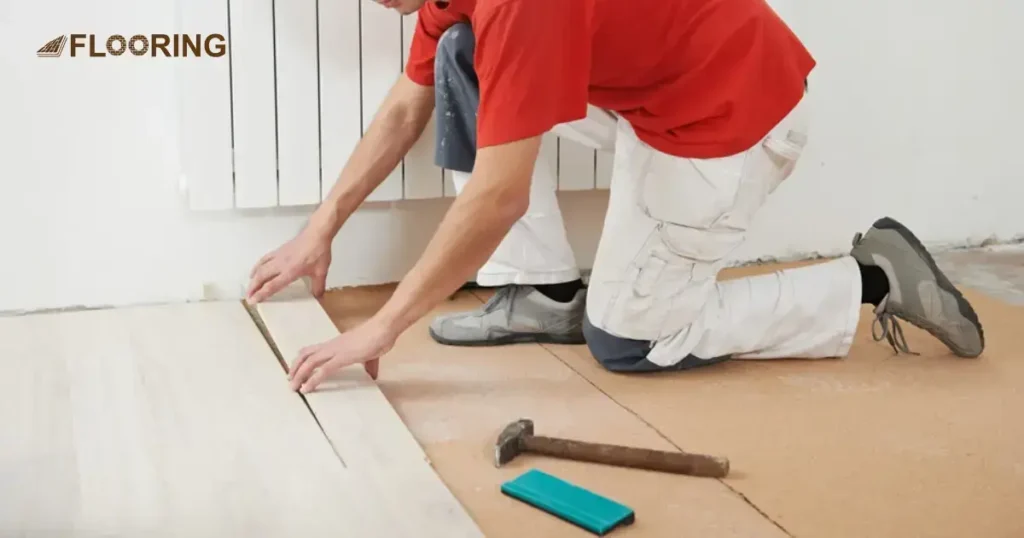
It is essential to have a flat tile surface when installing laminate flooring to ensure a successful outcome. If you come across any uneven tiles, using a leveling compound is the best way to address this issue. Smoothing out the subfloor and filling in any gaps or uneven areas are the best ways to address this issue.
Taking the time to level the surface not only saves time during the installation process but also contributes to the long-term durability and appearance of your laminate floor.
By establishing a stable and even foundation, you are reducing the chances of future damage. These future damages can include cracks caused by uneven pressure points, ultimately resulting in a high-quality finish for your flooring project.
Addressing Grout Lines
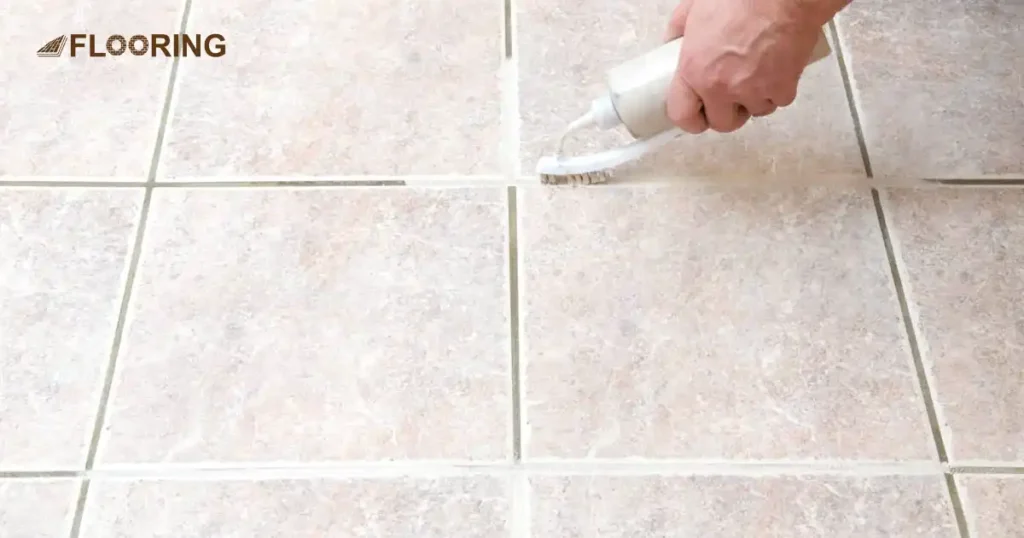
Grout lines can pose a challenge when installing laminate floor over tile. If grout lines are deep, they can create an uneven surface, leading to potential issues with the laminate.
To address this problem, consider filling in the grout lines with a leveling compound creating a smoother, more even surface for the laminate to rest on.
Apply the leveling compound carefully, ensuring it fills the grout lines completely. Once applied, allow the compound to dry according to the manufacturer’s instructions.
After drying, check the floor for any remaining uneven areas and sand them down if necessary. This extra step might seem tedious, but it’s crucial for achieving a professional-looking laminate floor.
Choosing The Best Underlayment for Laminate Over Tile
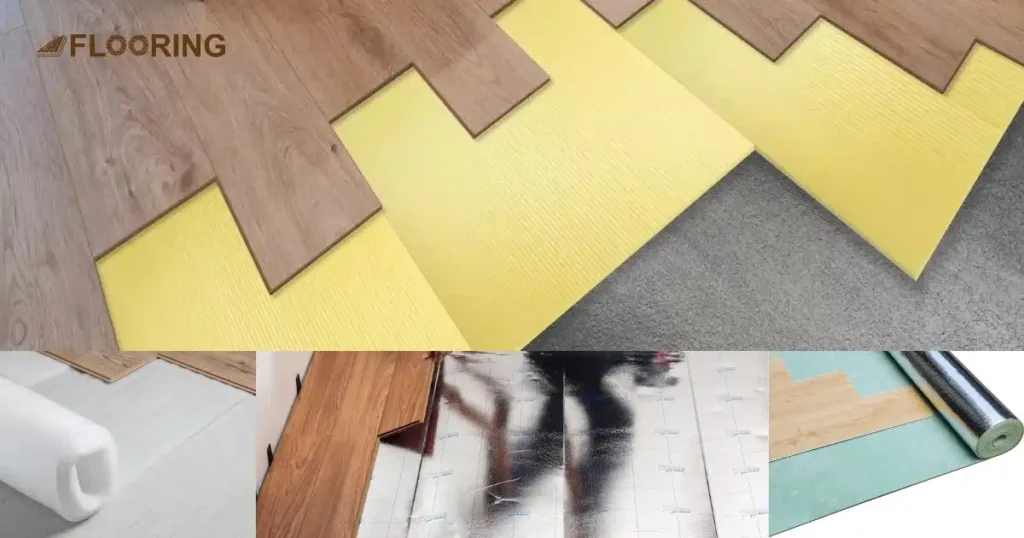
Selecting the right underlayment material is very crucial for a successful installation of laminate flooring over existing tile. By choosing foam or cork padding, you not only ensure a level surface for the planks but also protect against moisture, preventing potential water damage.
It’s important to follow the manufacturer’s guidelines to pick the underlayment that is most compatible with your specific laminate brand. The underlayment also offers advantages such as insulation and noise reduction.
This foundational layer plays a key role in achieving a long-lasting and visually appealing new floor, whether it’s for a residential or commercial space where laminate is being installed over tiled areas.
Proper Installation Techniques
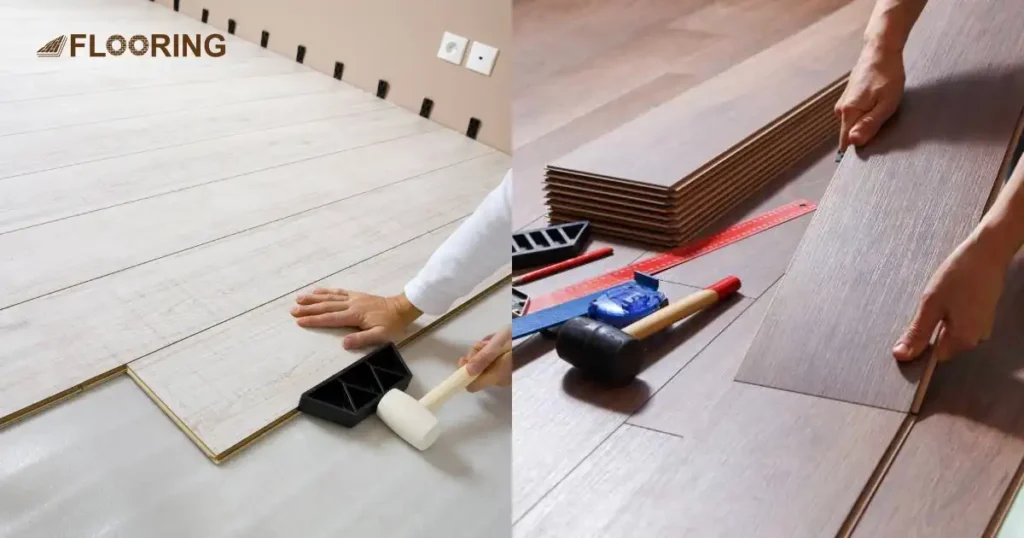
Opting for the appropriate click-lock laminate flooring product is key to a successful installation over tile, simplifying the entire process of laying down your new floors.
To start, strategically place spacers around immovable objects such as walls or pillars, maintaining a gap of at least 3/8 inches to allow for potential expansion in the future.
When it comes to installing laminate over existing tile, it’s essential to take advantage of features like Speedloc™ joint locks. These locks not only make assembly a breeze but also ensure a secure connection between each plank, streamlining the layering process.
By following the correct installation methods, you’re not only ensuring a sturdy and efficient flooring system. But also creating a visually appealing space that will withstand the test of time.
Tools and Materials Required for Laminate Flooring Installation Over Tiles
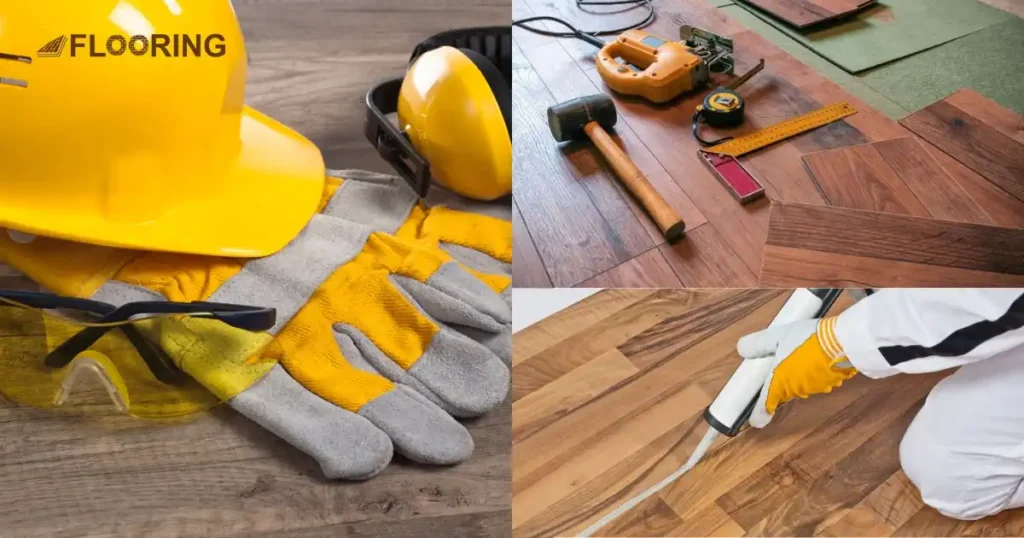
Before the process of installing laminate flooring on top of the tile, it is crucial to gather together all the required tools and materials. This encompasses measuring instruments, cutting tools, suitable adhesives or fasteners, as well as necessary safety equipment.
Measuring and Cutting Tools
Achieving a seamless installation of laminate flooring on top of tile requires attention to detail. It all begins with precise measurements and cutting of the laminate planks to fit the space perfectly.
To accomplish this task effectively, you will need essential tools like:
- A tape measure for accurate sizing.
- A selection of saws – such as a jigsaw, miter saw, or circular saw, to make clean and precise cuts.
- It is also important to mark your measurements with a pencil to ensure added accuracy and avoid any mistakes during the installation process.
- In areas where power outlets are limited or hard to reach, having a utility knife on hand can be quite useful.
By utilizing these tools properly, you can guarantee a flawless finish and a professional-looking result once your laminate flooring is successfully installed.
Adhesives and Fasteners
Selecting the right adhesive and fasteners plays a vital role in ensuring a secure and long-lasting installation of laminate over tile floor. Manufacturers typically provide guidelines on the best types of adhesives and fasteners to use with their products, ranging from:
- Construction Adhesive
- Nails
- Screws
- Staples
While construction adhesive offers a stronghold, it may require a professional application for optimal results. On the other hand, nails and screws are more user-friendly but may not provide as much stability as construction glue.
It is important to take into account factors such as the type of existing tile and your durability needs when choosing the adhesive and fasteners. This not only guarantees a successful installation but also helps in maintaining cost efficiency in the long run.
Safety Equipment
Before beginning the process of laying laminate flooring over tile, it is crucial to have all the required safety equipment on hand, all of which are essential for a safe and successful installation. This includes:
- Goggles for dust protection
- Knee pads
- A respirator mask
- Work gloves
- Earplugs
- Slip-resistant shoes
Ensuring you have all the necessary safety gear can minimize the risk of accidents or injuries during the flooring installation process. These precautions are simple yet effective ways to protect yourself and ensure that the project goes smoothly without any hiccups.
Step-by-Step Guide to Install Laminate Flooring Over Tiles
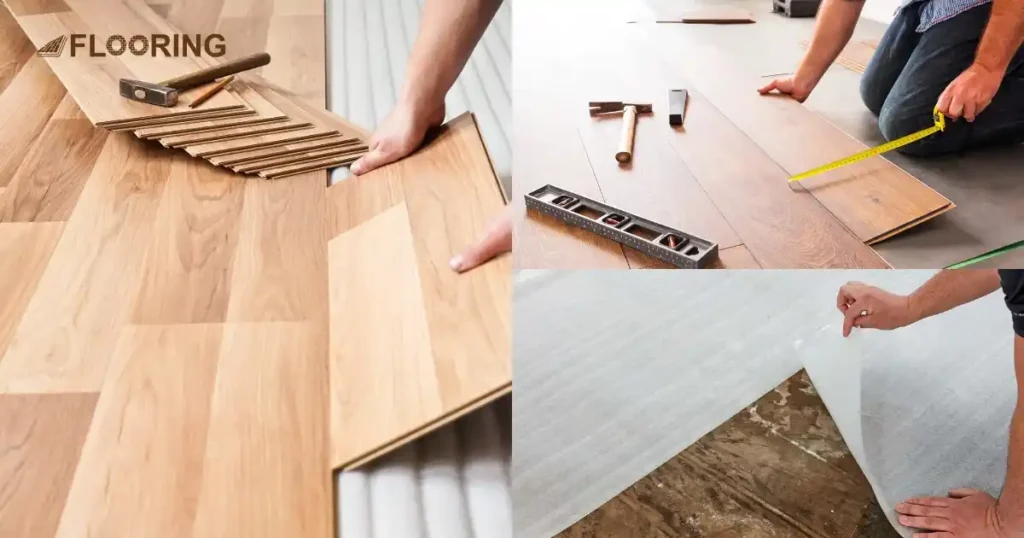
Installing laminate flooring over tiles is a manageable project with the right preparation and guidance. Follow this step-by-step guide to achieve a professional-looking finish. We will cover measuring and planning, installing the underlayment, and laying the laminate flooring.
Measuring and Planning
Before you start installing laminate flooring, precise measuring and planning are crucial.
Room Dimensions: Begin by measuring the dimensions of the room to determine how much laminate you’ll need. Don’t forget to account for a 10% overage to cover any mistakes or future repairs.
Sketch a layout Plan: Sketch a layout plan of the room, including any obstacles like doorways, cabinets, and vents. This helps you visualize the installation and plan the direction of the planks in which to lay laminate over tiles. Deciding on the direction early can make a big difference in the room’s final appearance.
Installing the Underlayment
Choose the Right Underlayment: Select an underlayment that suits your laminate flooring and the specific conditions of your room, such as moisture or noise reduction.
Roll Out the Underlayment: Begin at one end of the room and roll out the underlayment, ensuring it covers the entire floor area. Cut the underlayment to fit as needed.
Seal the Seams: Use adhesive tape to seal the seams between the underlayment sheets. This prevents them from shifting during installation and provides a continuous moisture barrier.
Trim the Excess: Trim any excess underlayment around the edges of the room to ensure a neat and tidy fit.
Secure the Underlayment: Secure the underlayment with tape or adhesive as recommended by the manufacturer, making sure it lies flat and smooth.
Laying the Laminate Flooring
Acclimate the Planks: Allow the laminate planks to acclimate to the room’s temperature and humidity for at least 48 hours before installation.
Start with the First Row: Begin laying the first row of planks along the longest wall, ensuring a 1/4-inch gap between the planks and the wall for expansion.
Snap the Planks Together: Use the click-lock mechanism to snap the planks together. Start from one end and work your way to the other, ensuring each plank is securely locked in place.
Stagger the Seams: Stagger the seams of the planks in each row to create a more natural and aesthetically pleasing look. Avoid lining up the seams too closely.
Cut Planks to Fit: Measure and cut the last plank in each row to fit, ensuring it leaves the same 1/4-inch gap at the wall. Use a saw for clean and precise cuts.
Finish the Edges: Once all the planks are laid, install baseboards or molding to cover the expansion gaps around the perimeter of the room. This gives your new floor a polished, finished look.
Common Challenges and Solutions When Installing Laminate Flooring Over Tile
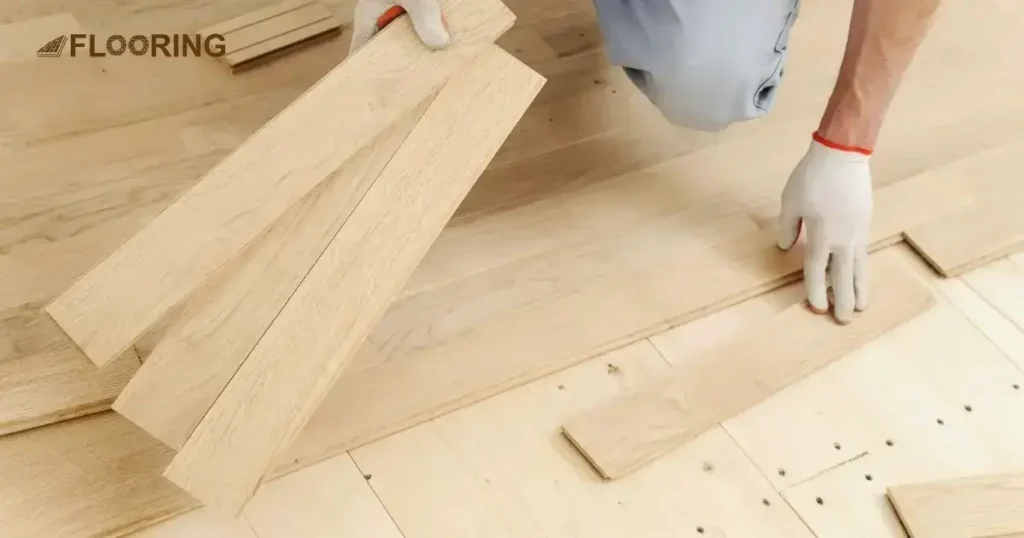
Transforming your existing tile floor with laminate can present some challenges. But with the right approach, it can be a rewarding project. Understanding how to address common issues like differences in floor height and moisture concerns is crucial for a smooth installation process.
By familiarizing yourself with the necessary techniques and solutions, you can ensure that your laminate-over-tile project is successful. With proper preparation and attention to detail, you can confidently tackle this renovation task and achieve the desired results.
Height Differences and Transitions
It is essential to carefully consider how to address any height differences between rooms when installing laminate flooring over tile. By utilizing transition strips, you can ensure a seamless transition from one type of flooring to another while also maintaining a cohesive look throughout your living space.
By proactively addressing these potential challenges with the proper use of transition strips, you can create a visually appealing outcome that seamlessly combines different flooring materials without compromising on style or elegance.
Moisture and Vapor Barriers
Protecting your laminate flooring from water damage is essential, and installing a moisture barrier is a key step in achieving this. These barriers serve as a protective shield against moisture, preventing issues like deterioration and mold growth from occurring.
The specific type of moisture protection required will depend on factors such as the materials of your subfloor and the environmental conditions in your location. It is important to carefully adhere to the guidelines provided by the manufacturer when installing these barriers to ensure their effectiveness.
Regular inspections of your flooring are crucial to detect any potential problems early on. By staying proactive and addressing issues promptly, you can help maintain the longevity and durability of both your tile and laminate flooring.
Dealing with Uneven or Damaged Tiles
Before installing laminate flooring, it is crucial to address any uneven or damaged tiles by repairing and leveling them accordingly. This can be achieved by using a leveling compound to create a smooth surface that will facilitate the installation of the new laminate floors seamlessly.
In cases where individual tiles are damaged, it is recommended to repair them using adhesive or resin before proceeding with the installation of the laminate floorboards. This will help ensure a uniform and stable foundation for the flooring.
By addressing and resolving these issues before laying down your formaldehyde-free wood flooring planks, you are setting the stage for a durable and visually appealing floor that will stand the test of time. Proper preparation is key to the long-term performance and aesthetics of your flooring, making it a crucial step in the installation process.
Maintenance and Care for Laminate Flooring Over Tile
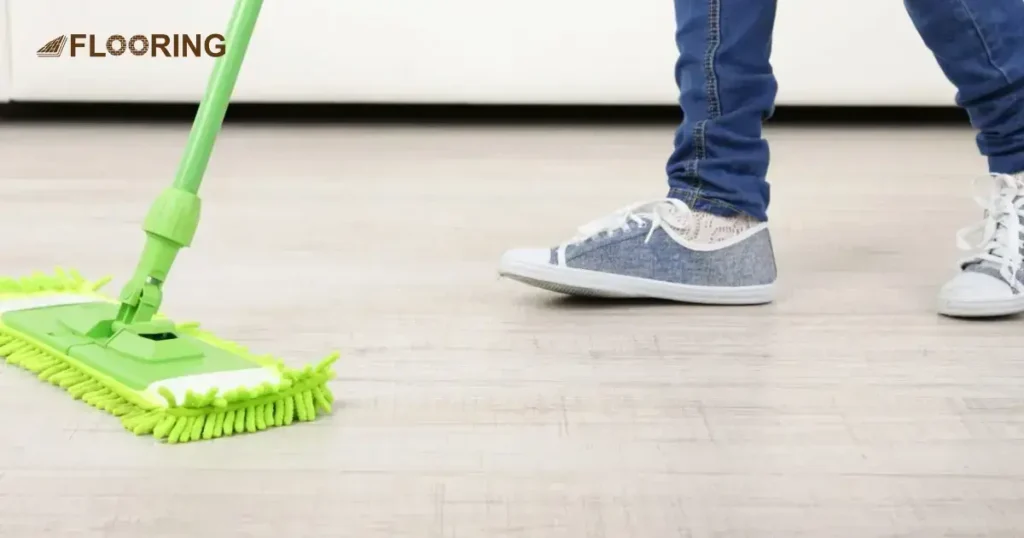
Proper maintenance and care are essential to maintain the quality of your laminate flooring installed over existing tiles. This guide covers effective cleaning techniques, damage prevention, and addressing minor issues that may occur with your laminate and wood floors.
By following these guidelines, you can ensure that your tiles remain in excellent condition and last for a longer period.
Cleaning Techniques
Maintaining your laminate flooring requires the right cleaning methods to ensure its longevity and appearance.
- Regular sweeping or vacuuming is essential to eliminate dirt and dust from the surface of your laminate floors.
- Mopping with lukewarm water and mild detergent is recommended for deeper cleaning while avoiding harsh chemicals that could damage the flooring.
- Avoid using steam mops and cleaners as they can also cause harm to your laminate floors.
- By properly caring for your laminate floors, you can help them maintain their pristine condition for many years.
Preventing Damages and Scratches
To maintain the pristine condition of your floors and ensure their longevity, consider placing rugs or mats in high-traffic areas. Using felt pads under furniture legs will effectively prevent any unsightly scratches. By taking these simple precautions, you can preserve the beauty and functionality of your floors for many years to come.
Repairing Minor Issues
For repairing scratches or chips, consider using a repair kit that is specifically designed for this purpose. You can use wood putty or filler for more significant marks that need to be addressed.
When to Call in the Professionals
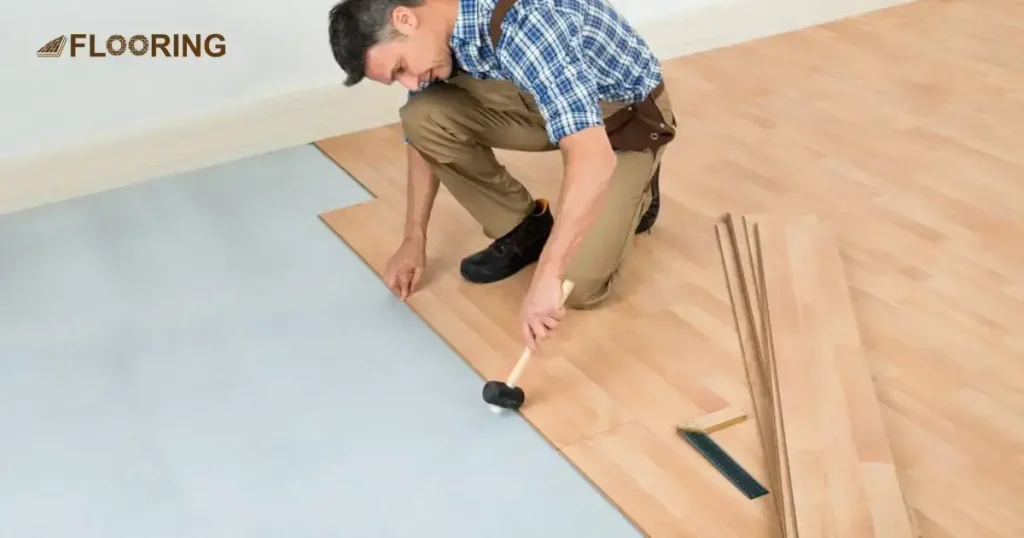
Some homeowners who are experienced in DIY projects may feel confident in installing laminate flooring over tile themselves.
However, if you come across any challenges such as cracked tiles or other complexities, it’s recommended to seek professional help. By doing so, you can ensure that the installation is done accurately, reducing the chances of encountering problems in the future.
If you’re unsure about whether you should lay laminate flooring on top of your current tile surface, it’s always a good idea to consult with an expert. Their knowledge and expertise will give you peace of mind, assuring you that your new flooring is securely installed. Don’t hesitate to reach out to a professional for guidance and assistance throughout the process.
Frequently Asked Questions
Is it better to remove tile before installing laminate flooring?
It is not advisable to install laminate flooring over damaged or unstable tiles, so it is best to remove them before laying down the laminate.
How much does it cost to install laminate flooring over tiles?
Prices for laminate flooring can fluctuate significantly based on factors like the quality of the material, the intricacy of the design, and local labor expenses. Typically, you should budget between $3 to $10 per square foot for both the materials and installation.
How do you level a laminate floor?
To achieve a level laminate floor, it is common practice to apply a leveling compound over the current tile floor. This helps to create a uniform and smooth surface, which is particularly crucial if the tiles are uneven or damaged.
Do you need underlay for laminate flooring on tiles?
Yes, you need underlay for laminate flooring over tiles. Underlay provides a smooth surface, reduces noise, and adds insulation.
What happens if you install laminate flooring without underlayment?
Installing laminate flooring without underlayment can lead to noise issues and a less comfortable feel underfoot. It may also reduce the floor’s lifespan due to a lack of moisture protection.
What is more expensive to install tile or laminate?
Installing tile is generally more expensive than laminate. Tile installation requires more labor and materials, increasing the overall cost.
What thickness of laminate flooring is best?
A thickness of 8-12 mm is ideal for laminate flooring. It provides durability, comfort, and better sound absorption.
Which direction do you lay laminate flooring?
Lay laminate flooring parallel to the longest wall or the main light source. This enhances the room’s appearance and creates a more cohesive look.
Conclusion
Installing laminate flooring over existing tiles can be a cost-effective and convenient option, saving you the hassle of removing the tiles. By carefully assessing your tile area and selecting the right underlayment, along with following proper installation techniques, you can effortlessly enhance the aesthetics and longevity of your home with a new laminate floor on top of the tiles.
Seek advice from experts and ensure you have the necessary materials and tools to tackle this project with confidence. Laminate flooring having wood advantages is more comfortable than the tiles. So, prepare yourself to enjoy a cozy and inviting atmosphere in your newly renovated space, all thanks to the addition of a stylish laminate floor.
